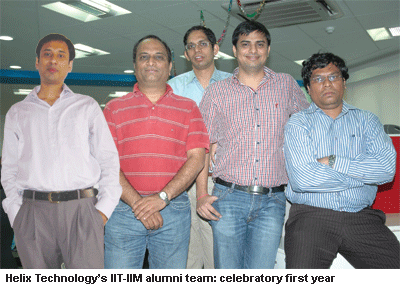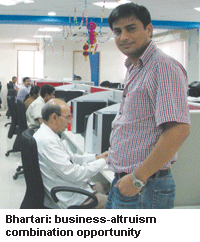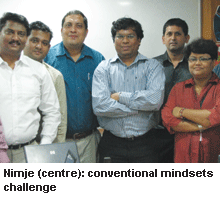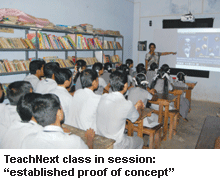Although late entrants into the ICT-in-education market, the young IIT-IIM promoters of the Hyderabad-based Helix Technology Solutions Pvt. Ltd claim the advantage of learning from the mistakes and wrong-turns of pioneer education technology companies. Dilip Thakore reports

The rush to market of private sector education entrepreneurs aka edupreneurs to offer ICT (information communication technologies)-aided learning services to India’s 1.8 million K-12 schools is getting heavier. In Hyderabad, the administrative capital of the south-eastern state of Andhra Pradesh (pop.76 million), unmindful of the sub-nationalist Telangana movement which threatens to trifurcate the state, a 330-strong ICT-in-schools company led by a team of young IIT-IIM alumni, who have banded together to take the school education market by storm, is set to celebrate its first year of sales operations on January 19.
Last January, Helix Technology Solutions Pvt. Ltd (HTS, incorporated: October 2007) launched LearnNext, its classes VI-X maths and science supplementary learning software program closely mapped with the syllabus prescribed by the Delhi-based National Council for Educational Research & Training (NCERT). The NCERT syllabus is closely followed by the Central Board of Secondary Education (CBSE), India’s largest pan-India schools and examinations board with 10,000 plus primary-secondaries affiliated with it, and broadly mapped by most state school examination boards. Since then despite minimal advertising and media hype, 40,000 units of LearnNext — curriculum-mapped CDs (compact discs) which enable students to supplement classroom lessons in maths and science with self-learning at home — have been sold (price: Rs.199-2,000 per year) country-wide.
Nine months later on November 1, the company launched TeachNext, an NCERT-curriculum mapped K-10 content box to enable teachers, and SchoolNext for institutional manage-ments. The company’s top management is jubilant about the response to these “carefully researched and market-condi-tioned teaching-learning programs”, which they believe will significantly improve learning outcomes for millions of students enroled in the country’s schools.
 “Helix Technology Solutions was born out of our dissatisfaction with the manner in which digitized content was being delivered to school students in India. Although there’s a growing number of education technology companies offering audio-visual content to K-12 students and teachers, most of them have merely digitized textbooks and offer very generic content. We discerned an opportunity to combine business with altruism by creating audio-visual content which would go beyond traditional teaching by using images, graphics and animation to simplify and explain science and maths concepts.
“Helix Technology Solutions was born out of our dissatisfaction with the manner in which digitized content was being delivered to school students in India. Although there’s a growing number of education technology companies offering audio-visual content to K-12 students and teachers, most of them have merely digitized textbooks and offer very generic content. We discerned an opportunity to combine business with altruism by creating audio-visual content which would go beyond traditional teaching by using images, graphics and animation to simplify and explain science and maths concepts.
“Moreover instead of providing cross-curriculum generic learning content, LearnNext, our very first product, offers maths and science content closely mapped with the NCERT VI-X curriculum, providing animated interactive experiments, simulation, study papers, question banks and comprehension assessment tests. Likewise our TeachNext NCERT-mapped content package enables teachers to deliver classroom lessons in an explanatory and interactive style. All our products are designed to dramatically improve student learning outcomes and upgrade the quality of instruction in the classrooms of the country’s 10,000 CBSE-affiliated schools to start with,” says Deependra Bhartari, the young co-promoter and director of HTS, who heads its content development and product research activities.
A chemical engineering graduate of IIT-Bombay (1999), Bhartari began his career as a software developer in Mahindra British Telecom, but quit a year later to join PartyGaming Plc — a Gibraltar/London-based online gaming start-up. Six years later after Party-Gaming went public with a valuation of $1 billion (Rs.4,500 crore), Bhartari together with two Indian colleagues — Kedar Choudhary and Raveendranth Kamath — put in his papers to promote HTS in 2007. Back home in Hyderabad, he expeditiously knitted a 200-strong team of schools teachers, writers and graphic designers to prepare the new company’s three flagship products — the B2C (business to consumer) LearnNext, B2B (business to business) TeachNext and SchoolNext.
Although Bhartari as well as Choudhary and Kamath who co-promoted Helix Technology Solutions are inclined to be reticent, the newly-promoted, closely-held HTS has an interesting history. The four London-based promoters of Party-Gaming (a pioneer of online internet-based gaming) were quick to discern the value of recruiting highly-qualified, English language-fluent Indian IT professionals to write the sophisticated, high-security software required for the high-risk internet gaming business.
In 2001 PartyGaming promoted Ivy Comptech Pvt. Ltd, a BPO (business process outsourcing) subsidiary based in Hyderabad with 1,200 employees to write and develop software programs required by the Gibraltar/London-based company, recruiting Bharatari and several IIT alumni to head the company’s BPO operations. To retain the services and enthusiasm of the IT professionals in India, they were given generous sweat equity in the parent company. In 2005 when PartyGaming went public with a listing on the London Stock Exchange and a market capitalisation of $1 billion, the trio became dollar millionaires. In end 2007, combining business savvy with altruism they promoted Helix Technology Solutions Pvt. Ltd, with an estimated paid-up capital of Rs.40 crore.
Since then the HTS top management has shown deep understanding of the grassroots realities of Indian school education by simplifying — indeed idiot-proofing — TeachNext which enables India’s conservative, risk-averse teachers to easily deliver the advanced NCERT K-10 curriculum in their classrooms. Although it’s politically correct to sing paeans to the teachers community on Teachers Day (Septe-mber 5) and other special occasions, the truth is that the overwhelming majority of them are demoralised, having to work in shockingly unconducive classroom environments for poor pay.
 For instance, in government primary-secondaries which constitute 80 percent of the country’s 1.87 million schools, rudimentary, crumbling classrooms with minimal furniture and multigrade teaching is the norm, while the country’s estimated 80,000 private primary-secondaries are characterised by autocratic managements, below-cost-of-living salaries and heavy workload. In the circumstances it’s hardly surprising that the great majority within the 5.5 million teachers’ community is resistant to computer-aided learning and infor-mation communication technologies, and there’s pervasive fear of blame-games following expensive ICT equipment and machinery going bust in classrooms.
For instance, in government primary-secondaries which constitute 80 percent of the country’s 1.87 million schools, rudimentary, crumbling classrooms with minimal furniture and multigrade teaching is the norm, while the country’s estimated 80,000 private primary-secondaries are characterised by autocratic managements, below-cost-of-living salaries and heavy workload. In the circumstances it’s hardly surprising that the great majority within the 5.5 million teachers’ community is resistant to computer-aided learning and infor-mation communication technologies, and there’s pervasive fear of blame-games following expensive ICT equipment and machinery going bust in classrooms.
“Our pre-launch market research indicated that the ICT products available to teachers were technology-heavy and user-unfriendly. Teachers were hesitant to use them because they weren’t sufficiently computer literate and/or feared damaging expensive equipment. Therefore apart from developing the user-friendly, curriculum-mapped B2C LearnNext package for students, we accorded high priority to also develop TeachNext for the teachers’ community. Given that most people including teachers, are comfortable using a remote control device to switch television channels, we developed a sturdy, reliable TeachNext Box which is essentially a set-top box pre-loaded with K-10 content, covering all subjects except languages,” says Kedar Choudhary, the co-promoter of HTS who heads the 18-strong technology development divi-sion. An alumnus of Marathawada University and IIT-Khargapur, Choud-hary began his career in 1993 with CMC Ltd (subsequently absorbed into Tata Consultancy Services) prior to signing with PartyGaming as their Hyderabad-based chief software architect in 1999.
According to Choudhary, the USP of the sealed TeachNext Box is that it can be easily operated like a television set-top box with a remote device. “All a teacher needs to do is to plug the TeachNext Box to a projector, television or computer terminal and choose her lesson just as she would a television channel. Moreover this revolutionary teacher-enabling invention — for which we have filed a global patent — has great potential in India and abroad because by using free open source software such as Linux, we have been able to price it at a mere Rs.4,500 per month per class. Likewise our SchoolNext ICT package is a scaled up version of the TeachNext Box allowing teachers to design lesson plans, draw up question papers and generate student assessment reports, and also includes school management and admin software. It’s priced at a mere Rs.35,000 per month for connecting five classrooms. We believe that these user-friendly teacher-empowerment ICT products have the potential to significantly improve learning outcomes in India’s classrooms,” explains Choudhary.
The satisfaction which Bharatari and Choudhary derive from introducing innovative user-friendly ICT products, targeting the country’s 10,000 — and multiplying — CBSE-affiliated schools for starters, is shared by Jai D’Costa a chartered accountant and IIM-Bangalore marketing alum who cut his teeth in Indian industry working for blue-chip corporates such as ITC and Bennett Coleman & Co, and as an entrepreneur (Kid Stuff Promotions Pvt. Ltd). D’Costa came aboard HTS as marketing director last January.
 “The market response to our first three ICT-driven products has been very positive. Currently we are on track to achieve our sales targets of 100,000 units for LearnNext, 10,000 for TeachNext and 500 for SchoolNext in the year ending March 31, 2010. Except perhaps for SchoolNext, which offers some commonplace features, our other two products are unique in the Indian marketplace. LearnNext is focused on helping class VI-X children to improve in science and maths. TeachNext is uniquely teacher and price friendly — a mere Rs.4,500 per month per class. The enthusiastic response to these products has established proof of concept. Now we are poised to scale up our production and market penetration. It’s pertinent to note that of the 82,000 private schools in India barely 3,500 are digitized. Therefore the potential demand is huge. Initially we are targeting CBSE schools. Once we have tested and proved our unique products, we will move towards meeting the needs of children and teachers of the remaining 70,000 private and million-plus government schools through public-private partnerships. The market is huge and wide open,” says D’Costa.
“The market response to our first three ICT-driven products has been very positive. Currently we are on track to achieve our sales targets of 100,000 units for LearnNext, 10,000 for TeachNext and 500 for SchoolNext in the year ending March 31, 2010. Except perhaps for SchoolNext, which offers some commonplace features, our other two products are unique in the Indian marketplace. LearnNext is focused on helping class VI-X children to improve in science and maths. TeachNext is uniquely teacher and price friendly — a mere Rs.4,500 per month per class. The enthusiastic response to these products has established proof of concept. Now we are poised to scale up our production and market penetration. It’s pertinent to note that of the 82,000 private schools in India barely 3,500 are digitized. Therefore the potential demand is huge. Initially we are targeting CBSE schools. Once we have tested and proved our unique products, we will move towards meeting the needs of children and teachers of the remaining 70,000 private and million-plus government schools through public-private partnerships. The market is huge and wide open,” says D’Costa.
 The pervasive sentiment that the newly-promoted company has hit upon the right product mix at the right time is shared by its frontline sales personnel who directly interface with conservative, change-averse customers in India’s schools sector. “The major challenge confronting us is not so much from other ICT product and service providers — the market is big enough for all — as from the conventional mindsets of school managements and teachers reluctant to change from the chalk-n-talk and blackboard style of teaching. Technology offers tremendous value addition to teaching-learning processes. Fortunately school managements and teacher attitudes towards ICT in education are changing, and the encouraging response we are getting for our student and teacher-friendly products has convinced me that we are in the right business at the right time with the right products,” says Prashant Nimje, an alumnus of the Regional Engineering College, Nagpur and IIM-Ahmedabad who as director of sales, heads HTS’ 75-strong team of business develop-ment managers.
The pervasive sentiment that the newly-promoted company has hit upon the right product mix at the right time is shared by its frontline sales personnel who directly interface with conservative, change-averse customers in India’s schools sector. “The major challenge confronting us is not so much from other ICT product and service providers — the market is big enough for all — as from the conventional mindsets of school managements and teachers reluctant to change from the chalk-n-talk and blackboard style of teaching. Technology offers tremendous value addition to teaching-learning processes. Fortunately school managements and teacher attitudes towards ICT in education are changing, and the encouraging response we are getting for our student and teacher-friendly products has convinced me that we are in the right business at the right time with the right products,” says Prashant Nimje, an alumnus of the Regional Engineering College, Nagpur and IIM-Ahmedabad who as director of sales, heads HTS’ 75-strong team of business develop-ment managers.
Bolstering their enthusiasm is the endorsement by students of the smart LearnNext software. Comments Tara Sharma, a class X student of the Army School, Mhow, Madhya Pradesh: “The Learn-Next science and maths supplementary learning package which we downloaded from the internet, has proved very useful. It is closely mapped with the CBSE curriculum and is easy to use. New features like animation make learning these subjects more exciting.”
Adds Nikhil Prakash a class XI student of the MGM Secondary School, Bhilai Nagar, Chhatisgarh: “Before I started using LearnNext, I was very weak in maths and science. But the excellent animations and user-friendly technology of LearnNext revived my interest in these subjects and enabled me to score 69 percent in maths and 62 percent in science in my CBSE class X exam last year — scores I had never expected.”
The teachers’ community for whom HTS has designed its TeachNext Box — a hardy and durable console containing NCERT curriculum lesson plans for each subject and grade, and operated by a control panel modeled on a television remote — is likely to prove more difficult to crack. It is now common knowledge that teachers — even in upscale private schools — tend to be reluctant to switch to computer-aided pedagogies for a variety of reasons. Among them: conservatism; pervasive fear that their students may be more computer-literate than them; apprehension about damaging expensive equipment and hardware. Consequently despite pioneer ICT-in-education companies such as IL&FS-ETS, Educomp Solutions, Everonn Education, NIIT among others making contem-porary ICT-driven teaching-learning systems available on the highly affordable BOOT (build, operate, own and transfer model) to school managements, barely 3 percent of the country’s 162,000 secondary schools are equipped with computer-aided learning systems. And in the majority of schools in which online systems are installed, they tend to be under-utilised.
 According to HTS spokespersons, TeachNext and its scaled up version SchoolNext have been specifically designed to allay fear of new computer-aided learning technologies within the country’s 5.5 million teachers’ commu-nity. Thus the hardware of the TeachNext system is deliberately divorced from the computer and patter-ned upon the ubiquitous television set. Moreover it’s priced at a rock-bottom and reassuring Rs.4,500 per class. The SchoolNext system designed for institutional managements which can connect five classrooms through a server is also modestly priced (Rs.35,000) and comes with a trained facilitator to manage and operate the system.
According to HTS spokespersons, TeachNext and its scaled up version SchoolNext have been specifically designed to allay fear of new computer-aided learning technologies within the country’s 5.5 million teachers’ commu-nity. Thus the hardware of the TeachNext system is deliberately divorced from the computer and patter-ned upon the ubiquitous television set. Moreover it’s priced at a rock-bottom and reassuring Rs.4,500 per class. The SchoolNext system designed for institutional managements which can connect five classrooms through a server is also modestly priced (Rs.35,000) and comes with a trained facilitator to manage and operate the system.
This strategy, of making a conscious effort to remove fear of new ICT systems within the collective minds of teachers and school managements seems to be paying off. “We have installed the TeachNext system in all our classrooms and are highly satisfied with the product because students are enthused to learn, the animations are superb, and the quality of learning games is excellent,” says Manoj Mohanta, the promoter principal of the Lyceum School, Gurgaon (estb.2004) which has an aggregate enrolment of 180 students instructed by 21 teachers.
Likewise, Chitra Vishwanath, principal of Prama Bhattara Kendriya Vidyalaya, a Central government promoted primary-secondary (estb. 1992) in Ernakulam (Kerala) with an aggregate enrolment of 900 students, is a satisfied customer. “Following a demonstration of the teacher-friendly features of TeachNext last summer, our staff unanimously voted for installation of the system in grade V-X classrooms. Since then it has proved easy to use, and our teachers’ lesson planning and productivity have improved consider-ably,” says Vishwanath.
With market validation of Helix Technology’s focused and user-friendly products and marketing strategies, it’s hardly surprising that the top manage-ment of the company which completes a full year of operations on January 19, believes they’ve got off to a flying start. While admitting that HTS is a late entrant into India’s high-potential computer-led learning market, they believe the company has the advantage of learning from the mistakes and wrong turns of pioneer ICT-in- education companies.
 “The market response to our products is very encouraging. A customer survey conducted by us in October indicates 85 percent satisfaction with our three initial products, with 10 percent of respondents neutral. On the parameters of focus, price and user-friendliness, our ICT teaching and learning packages are the best in the marketplace and make education an engaging and joyous experience for teachers and students. For us at Helix Technology, this is a mentally, socially and economically beneficial mission to which we are committed to giving our best in the years to come, with the larger objective of raising Indian education to global standards,” says Raveendranath Kamath, an alumnus of IIT-Kharagpur and currently the Kochi (Kerala)-based co-promoter and director of the company’s operations.
“The market response to our products is very encouraging. A customer survey conducted by us in October indicates 85 percent satisfaction with our three initial products, with 10 percent of respondents neutral. On the parameters of focus, price and user-friendliness, our ICT teaching and learning packages are the best in the marketplace and make education an engaging and joyous experience for teachers and students. For us at Helix Technology, this is a mentally, socially and economically beneficial mission to which we are committed to giving our best in the years to come, with the larger objective of raising Indian education to global standards,” says Raveendranath Kamath, an alumnus of IIT-Kharagpur and currently the Kochi (Kerala)-based co-promoter and director of the company’s operations.
Late entrants into the ICT-in-education market, the four-musketeers of Helix Technology — whose number, true to the eponymous classic of Alexander Dumas, is actually more — seem in a hurry to make up for lost time and opportunities. Which may not be good news for the multiplying number of companies in the race for market share, but for teachers and students strugg-ling in millions of classrooms across the country, it’s a favourable development promising improved real learning outcomes.
With Summiya Yasmeen (Hyderabad)